Integrated Marketing Communications: Analysis and Strategies (Term 1)
VerifiedAdded on 2020/11/05
|25
|5217
|37
Report
AI Summary
This report provides a detailed overview of Integrated Marketing Communications (IMC), emphasizing the importance of blending different communication strategies. It covers various aspects of marketing communications, including advertising, public relations, sponsorship, and digital marketing. The report differentiates between advertising and promotion, explaining the AIDA model and the marketing communications mix. It delves into media vehicle decisions, scheduling, and the impact of reach and frequency. Public relations methods, including media relations, events, and crisis management, are discussed, along with digital and social media strategies. The report also explores personal selling, direct marketing, relationship marketing, and the differences between B2C and B2B marketing, providing a comprehensive understanding of IMC principles and practices. Finally, corporate communications and crisis management are also covered.
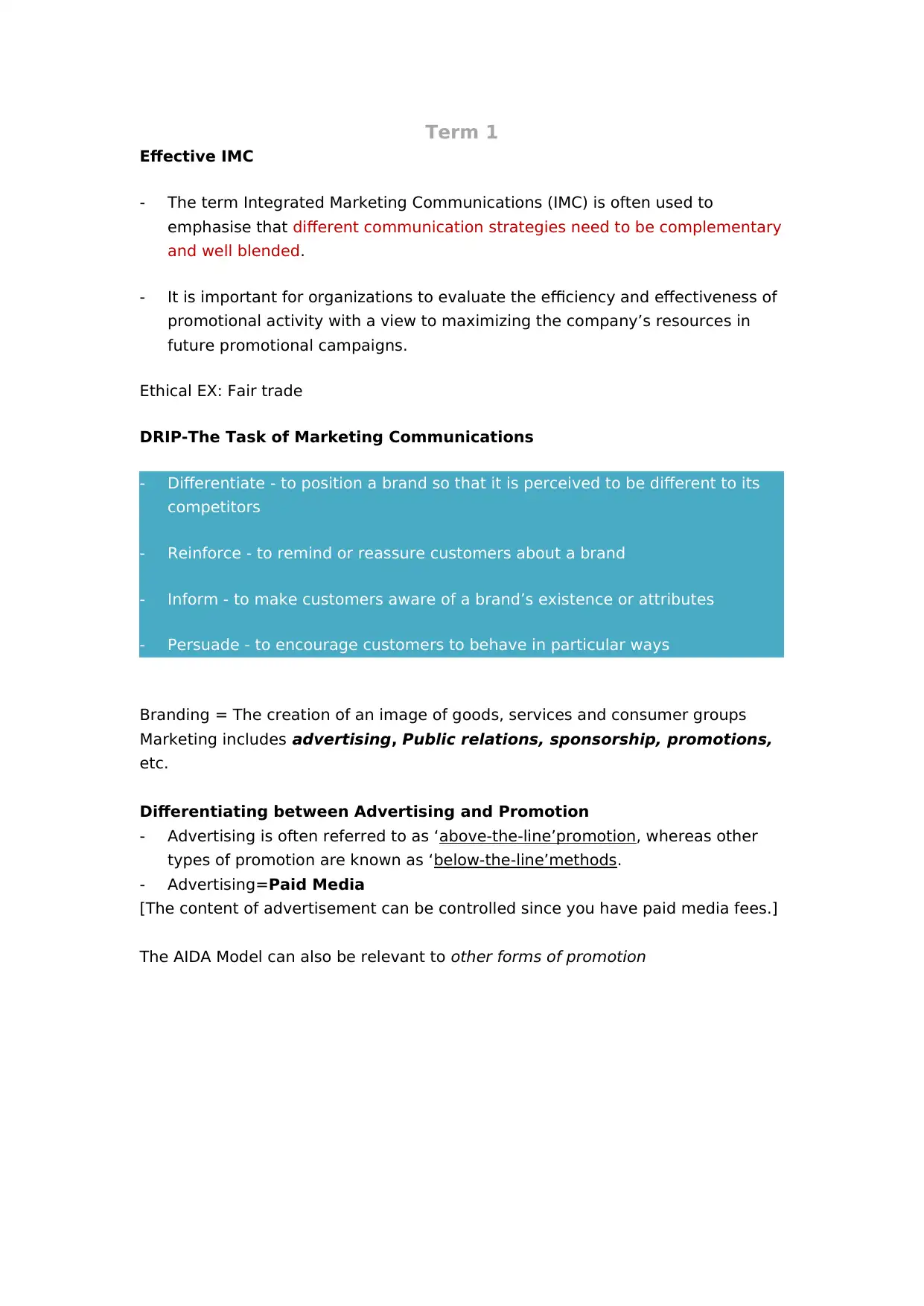
Term 1
Effective IMC
- The term Integrated Marketing Communications (IMC) is often used to
emphasise that different communication strategies need to be complementary
and well blended.
- It is important for organizations to evaluate the efficiency and effectiveness of
promotional activity with a view to maximizing the company’s resources in
future promotional campaigns.
Ethical EX: Fair trade
DRIP-The Task of Marketing Communications
- Differentiate - to position a brand so that it is perceived to be different to its
competitors
- Reinforce - to remind or reassure customers about a brand
- Inform - to make customers aware of a brand’s existence or attributes
- Persuade - to encourage customers to behave in particular ways
Branding = The creation of an image of goods, services and consumer groups
Marketing includes advertising, Public relations, sponsorship, promotions,
etc.
Differentiating between Advertising and Promotion
- Advertising is often referred to as ‘above-the-line’promotion, whereas other
types of promotion are known as ‘below-the-line’methods.
- Advertising=Paid Media
[The content of advertisement can be controlled since you have paid media fees.]
The AIDA Model can also be relevant to other forms of promotion
Effective IMC
- The term Integrated Marketing Communications (IMC) is often used to
emphasise that different communication strategies need to be complementary
and well blended.
- It is important for organizations to evaluate the efficiency and effectiveness of
promotional activity with a view to maximizing the company’s resources in
future promotional campaigns.
Ethical EX: Fair trade
DRIP-The Task of Marketing Communications
- Differentiate - to position a brand so that it is perceived to be different to its
competitors
- Reinforce - to remind or reassure customers about a brand
- Inform - to make customers aware of a brand’s existence or attributes
- Persuade - to encourage customers to behave in particular ways
Branding = The creation of an image of goods, services and consumer groups
Marketing includes advertising, Public relations, sponsorship, promotions,
etc.
Differentiating between Advertising and Promotion
- Advertising is often referred to as ‘above-the-line’promotion, whereas other
types of promotion are known as ‘below-the-line’methods.
- Advertising=Paid Media
[The content of advertisement can be controlled since you have paid media fees.]
The AIDA Model can also be relevant to other forms of promotion
Paraphrase This Document
Need a fresh take? Get an instant paraphrase of this document with our AI Paraphraser
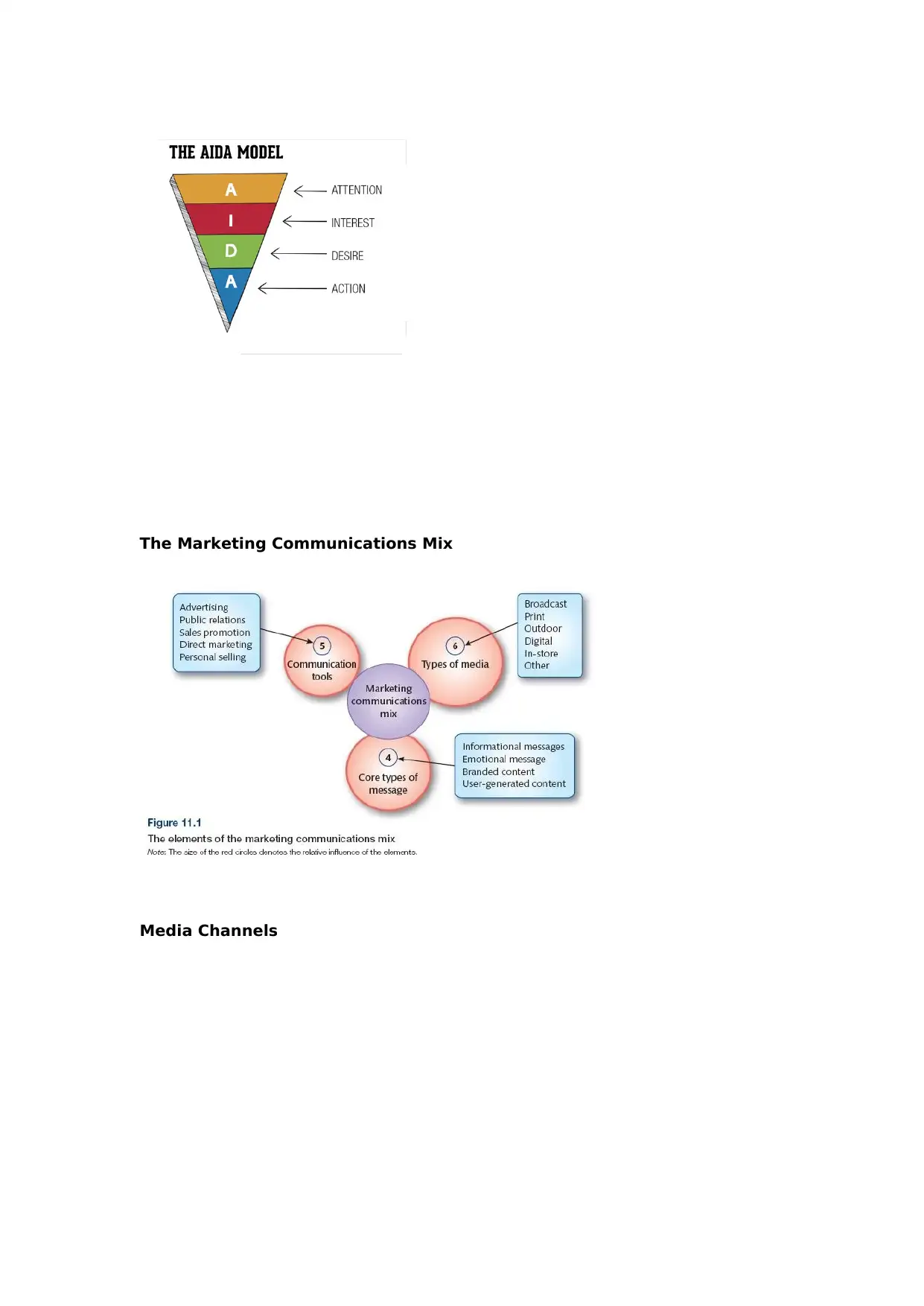
The Marketing Communications Mix
Media Channels
Media Channels

Marketing Communications Practice
- In-house marketing team (may be split into advertising and PR)
- Full-service agencies (strategy; planning; implementation)
- Specialist agencies (digital; PR; advertising; MR)
The Planning Strategy:
Marketing Communication Strategy should derive directly from marketing
strategy which in turn derives directly from corporate strategy.
Media Vehicle Decisions
- Media vehicle decisions should be based on readership, viewership,
listenership figures etc.
- Media planners must also have information on the emotional aspects of media
consumption, its social & cultural context and its meaning in consumers’lives.
Scheduling Issues
· Reach
- The number of individuals reached at least Minimum Effective Frequency.
· Effective Frequency
- To raise disposition to purchase to the action threshold with the fewest
insertions (the lowest cost)
· Wear-Out
- Occurs when successive exposures no longer have a positive impact on the
audience.
- Too many exposures may turn disposition to purchase in a negative direction.
PR=Earned Media Exposure
PR concerns ‘establishing and maintaining good relations with different public
stakeholders in order to facilitate the marketing function’.
[One of the main functions of PR is to communicate through the media to gain
public attention and awareness.]
- In-house marketing team (may be split into advertising and PR)
- Full-service agencies (strategy; planning; implementation)
- Specialist agencies (digital; PR; advertising; MR)
The Planning Strategy:
Marketing Communication Strategy should derive directly from marketing
strategy which in turn derives directly from corporate strategy.
Media Vehicle Decisions
- Media vehicle decisions should be based on readership, viewership,
listenership figures etc.
- Media planners must also have information on the emotional aspects of media
consumption, its social & cultural context and its meaning in consumers’lives.
Scheduling Issues
· Reach
- The number of individuals reached at least Minimum Effective Frequency.
· Effective Frequency
- To raise disposition to purchase to the action threshold with the fewest
insertions (the lowest cost)
· Wear-Out
- Occurs when successive exposures no longer have a positive impact on the
audience.
- Too many exposures may turn disposition to purchase in a negative direction.
PR=Earned Media Exposure
PR concerns ‘establishing and maintaining good relations with different public
stakeholders in order to facilitate the marketing function’.
[One of the main functions of PR is to communicate through the media to gain
public attention and awareness.]
⊘ This is a preview!⊘
Do you want full access?
Subscribe today to unlock all pages.

Trusted by 1+ million students worldwide
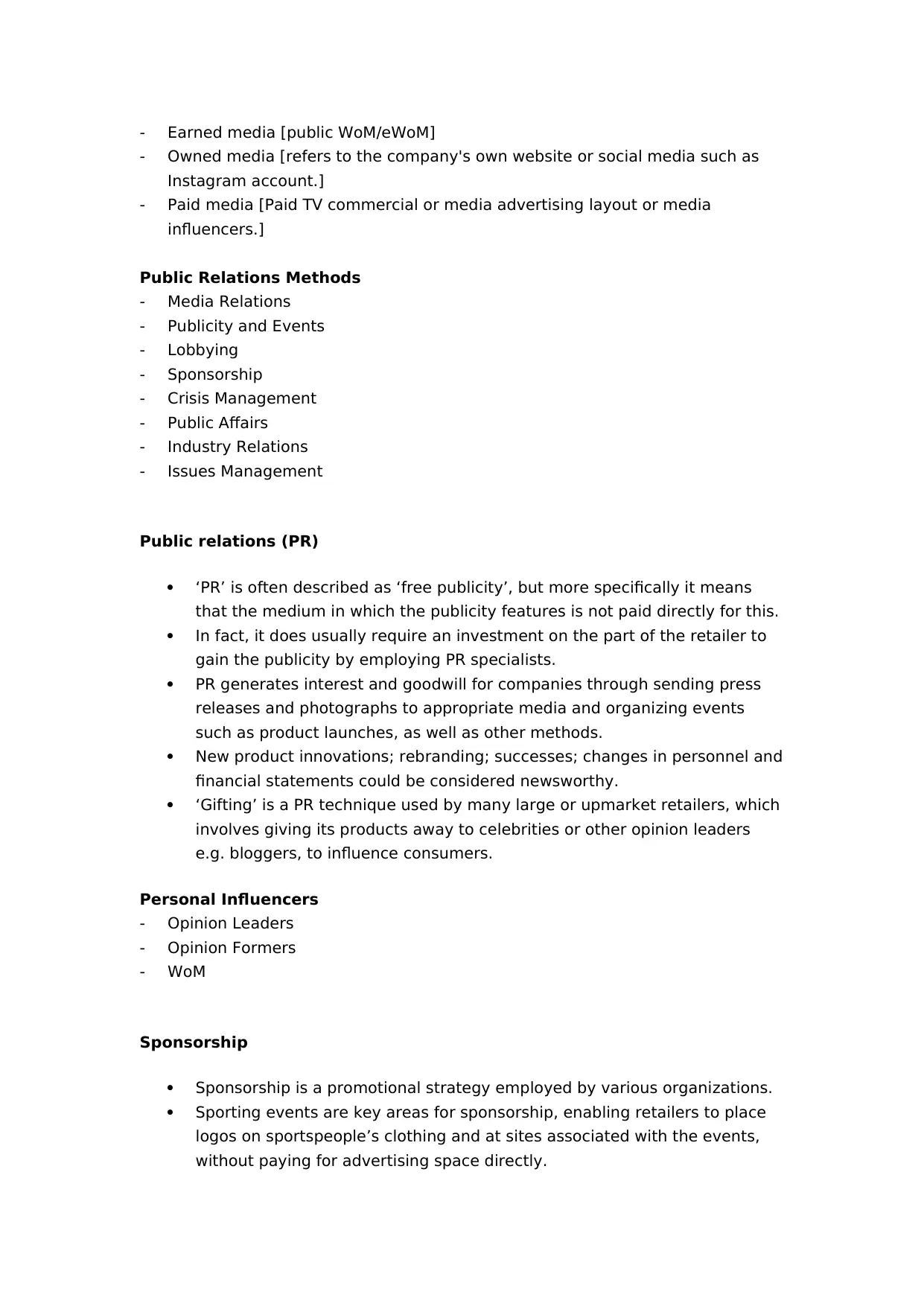
- Earned media [public WoM/eWoM]
- Owned media [refers to the company's own website or social media such as
Instagram account.]
- Paid media [Paid TV commercial or media advertising layout or media
influencers.]
Public Relations Methods
- Media Relations
- Publicity and Events
- Lobbying
- Sponsorship
- Crisis Management
- Public Affairs
- Industry Relations
- Issues Management
Public relations (PR)
‘PR’ is often described as ‘free publicity’, but more specifically it means
that the medium in which the publicity features is not paid directly for this.
In fact, it does usually require an investment on the part of the retailer to
gain the publicity by employing PR specialists.
PR generates interest and goodwill for companies through sending press
releases and photographs to appropriate media and organizing events
such as product launches, as well as other methods.
New product innovations; rebranding; successes; changes in personnel and
financial statements could be considered newsworthy.
‘Gifting’ is a PR technique used by many large or upmarket retailers, which
involves giving its products away to celebrities or other opinion leaders
e.g. bloggers, to influence consumers.
Personal Influencers
- Opinion Leaders
- Opinion Formers
- WoM
Sponsorship
Sponsorship is a promotional strategy employed by various organizations.
Sporting events are key areas for sponsorship, enabling retailers to place
logos on sportspeople’s clothing and at sites associated with the events,
without paying for advertising space directly.
- Owned media [refers to the company's own website or social media such as
Instagram account.]
- Paid media [Paid TV commercial or media advertising layout or media
influencers.]
Public Relations Methods
- Media Relations
- Publicity and Events
- Lobbying
- Sponsorship
- Crisis Management
- Public Affairs
- Industry Relations
- Issues Management
Public relations (PR)
‘PR’ is often described as ‘free publicity’, but more specifically it means
that the medium in which the publicity features is not paid directly for this.
In fact, it does usually require an investment on the part of the retailer to
gain the publicity by employing PR specialists.
PR generates interest and goodwill for companies through sending press
releases and photographs to appropriate media and organizing events
such as product launches, as well as other methods.
New product innovations; rebranding; successes; changes in personnel and
financial statements could be considered newsworthy.
‘Gifting’ is a PR technique used by many large or upmarket retailers, which
involves giving its products away to celebrities or other opinion leaders
e.g. bloggers, to influence consumers.
Personal Influencers
- Opinion Leaders
- Opinion Formers
- WoM
Sponsorship
Sponsorship is a promotional strategy employed by various organizations.
Sporting events are key areas for sponsorship, enabling retailers to place
logos on sportspeople’s clothing and at sites associated with the events,
without paying for advertising space directly.
Paraphrase This Document
Need a fresh take? Get an instant paraphrase of this document with our AI Paraphraser
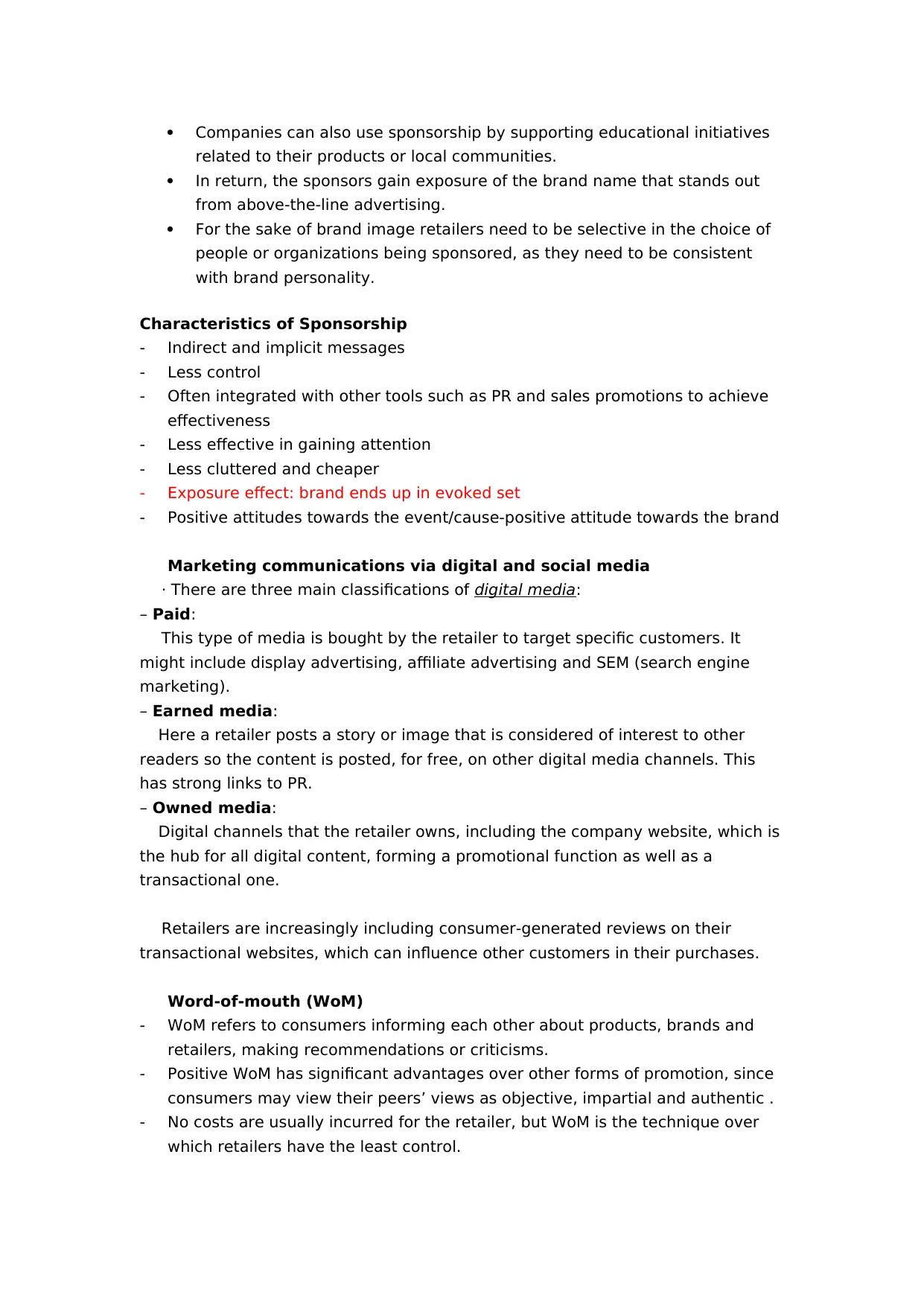
Companies can also use sponsorship by supporting educational initiatives
related to their products or local communities.
In return, the sponsors gain exposure of the brand name that stands out
from above-the-line advertising.
For the sake of brand image retailers need to be selective in the choice of
people or organizations being sponsored, as they need to be consistent
with brand personality.
Characteristics of Sponsorship
- Indirect and implicit messages
- Less control
- Often integrated with other tools such as PR and sales promotions to achieve
effectiveness
- Less effective in gaining attention
- Less cluttered and cheaper
- Exposure effect: brand ends up in evoked set
- Positive attitudes towards the event/cause-positive attitude towards the brand
Marketing communications via digital and social media
· There are three main classifications of digital media:
– Paid:
This type of media is bought by the retailer to target specific customers. It
might include display advertising, affiliate advertising and SEM (search engine
marketing).
– Earned media:
Here a retailer posts a story or image that is considered of interest to other
readers so the content is posted, for free, on other digital media channels. This
has strong links to PR.
– Owned media:
Digital channels that the retailer owns, including the company website, which is
the hub for all digital content, forming a promotional function as well as a
transactional one.
Retailers are increasingly including consumer-generated reviews on their
transactional websites, which can influence other customers in their purchases.
Word-of-mouth (WoM)
- WoM refers to consumers informing each other about products, brands and
retailers, making recommendations or criticisms.
- Positive WoM has significant advantages over other forms of promotion, since
consumers may view their peers’ views as objective, impartial and authentic .
- No costs are usually incurred for the retailer, but WoM is the technique over
which retailers have the least control.
related to their products or local communities.
In return, the sponsors gain exposure of the brand name that stands out
from above-the-line advertising.
For the sake of brand image retailers need to be selective in the choice of
people or organizations being sponsored, as they need to be consistent
with brand personality.
Characteristics of Sponsorship
- Indirect and implicit messages
- Less control
- Often integrated with other tools such as PR and sales promotions to achieve
effectiveness
- Less effective in gaining attention
- Less cluttered and cheaper
- Exposure effect: brand ends up in evoked set
- Positive attitudes towards the event/cause-positive attitude towards the brand
Marketing communications via digital and social media
· There are three main classifications of digital media:
– Paid:
This type of media is bought by the retailer to target specific customers. It
might include display advertising, affiliate advertising and SEM (search engine
marketing).
– Earned media:
Here a retailer posts a story or image that is considered of interest to other
readers so the content is posted, for free, on other digital media channels. This
has strong links to PR.
– Owned media:
Digital channels that the retailer owns, including the company website, which is
the hub for all digital content, forming a promotional function as well as a
transactional one.
Retailers are increasingly including consumer-generated reviews on their
transactional websites, which can influence other customers in their purchases.
Word-of-mouth (WoM)
- WoM refers to consumers informing each other about products, brands and
retailers, making recommendations or criticisms.
- Positive WoM has significant advantages over other forms of promotion, since
consumers may view their peers’ views as objective, impartial and authentic .
- No costs are usually incurred for the retailer, but WoM is the technique over
which retailers have the least control.
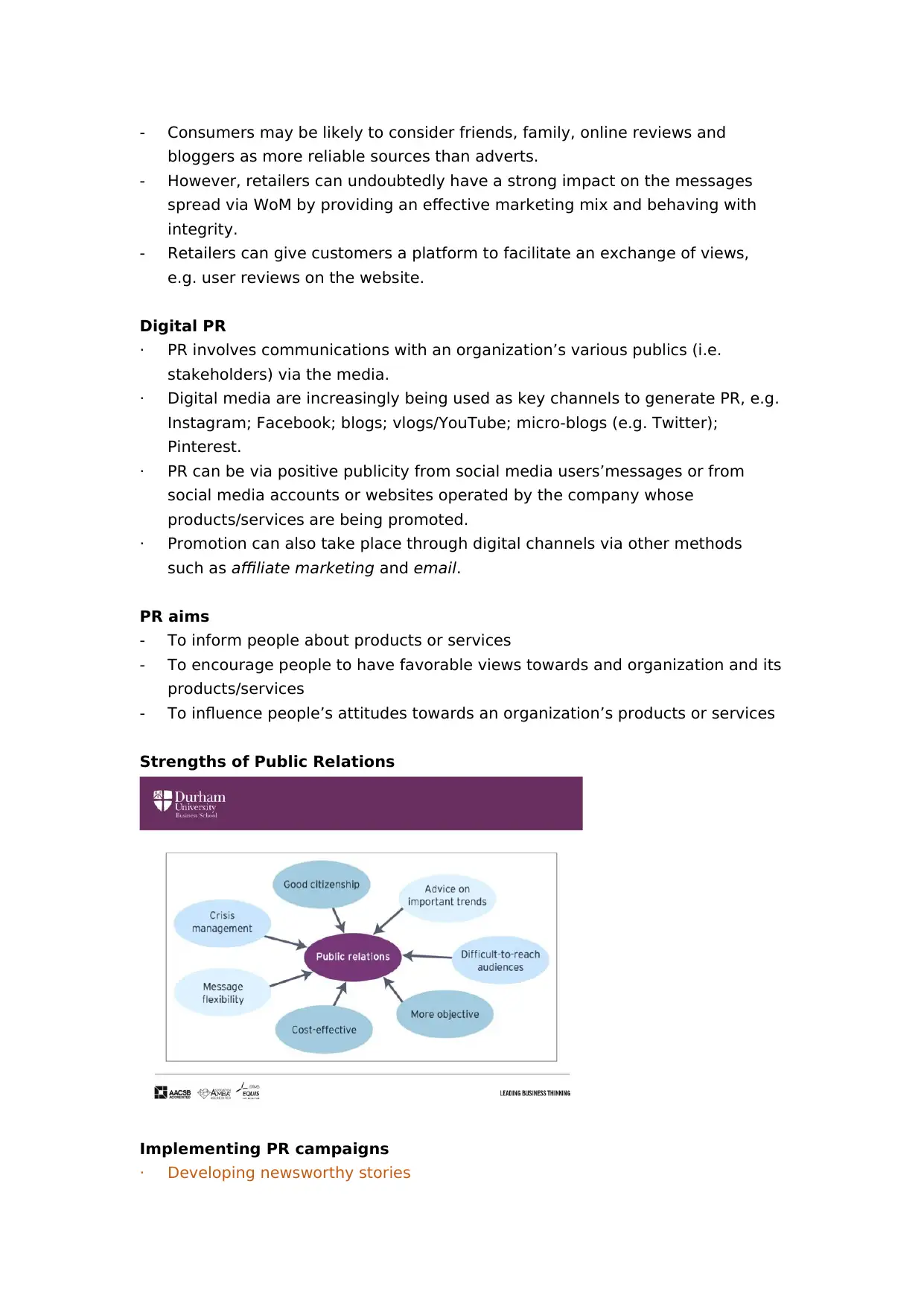
- Consumers may be likely to consider friends, family, online reviews and
bloggers as more reliable sources than adverts.
- However, retailers can undoubtedly have a strong impact on the messages
spread via WoM by providing an effective marketing mix and behaving with
integrity.
- Retailers can give customers a platform to facilitate an exchange of views,
e.g. user reviews on the website.
Digital PR
· PR involves communications with an organization’s various publics (i.e.
stakeholders) via the media.
· Digital media are increasingly being used as key channels to generate PR, e.g.
Instagram; Facebook; blogs; vlogs/YouTube; micro-blogs (e.g. Twitter);
Pinterest.
· PR can be via positive publicity from social media users’messages or from
social media accounts or websites operated by the company whose
products/services are being promoted.
· Promotion can also take place through digital channels via other methods
such as affiliate marketing and email.
PR aims
- To inform people about products or services
- To encourage people to have favorable views towards and organization and its
products/services
- To influence people’s attitudes towards an organization’s products or services
Strengths of Public Relations
Implementing PR campaigns
· Developing newsworthy stories
bloggers as more reliable sources than adverts.
- However, retailers can undoubtedly have a strong impact on the messages
spread via WoM by providing an effective marketing mix and behaving with
integrity.
- Retailers can give customers a platform to facilitate an exchange of views,
e.g. user reviews on the website.
Digital PR
· PR involves communications with an organization’s various publics (i.e.
stakeholders) via the media.
· Digital media are increasingly being used as key channels to generate PR, e.g.
Instagram; Facebook; blogs; vlogs/YouTube; micro-blogs (e.g. Twitter);
Pinterest.
· PR can be via positive publicity from social media users’messages or from
social media accounts or websites operated by the company whose
products/services are being promoted.
· Promotion can also take place through digital channels via other methods
such as affiliate marketing and email.
PR aims
- To inform people about products or services
- To encourage people to have favorable views towards and organization and its
products/services
- To influence people’s attitudes towards an organization’s products or services
Strengths of Public Relations
Implementing PR campaigns
· Developing newsworthy stories
⊘ This is a preview!⊘
Do you want full access?
Subscribe today to unlock all pages.

Trusted by 1+ million students worldwide
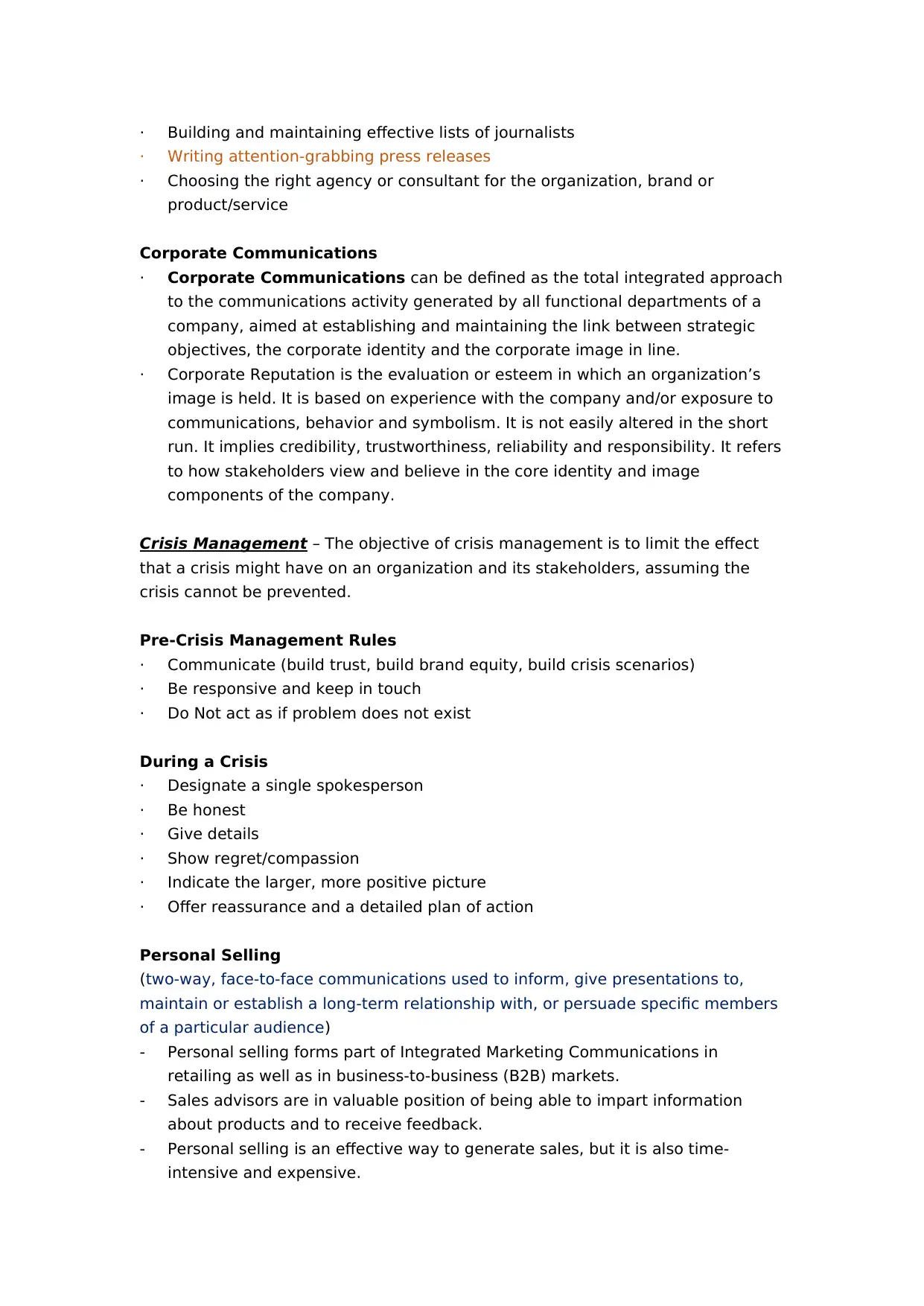
· Building and maintaining effective lists of journalists
· Writing attention-grabbing press releases
· Choosing the right agency or consultant for the organization, brand or
product/service
Corporate Communications
· Corporate Communications can be defined as the total integrated approach
to the communications activity generated by all functional departments of a
company, aimed at establishing and maintaining the link between strategic
objectives, the corporate identity and the corporate image in line.
· Corporate Reputation is the evaluation or esteem in which an organization’s
image is held. It is based on experience with the company and/or exposure to
communications, behavior and symbolism. It is not easily altered in the short
run. It implies credibility, trustworthiness, reliability and responsibility. It refers
to how stakeholders view and believe in the core identity and image
components of the company.
Crisis Management – The objective of crisis management is to limit the effect
that a crisis might have on an organization and its stakeholders, assuming the
crisis cannot be prevented.
Pre-Crisis Management Rules
· Communicate (build trust, build brand equity, build crisis scenarios)
· Be responsive and keep in touch
· Do Not act as if problem does not exist
During a Crisis
· Designate a single spokesperson
· Be honest
· Give details
· Show regret/compassion
· Indicate the larger, more positive picture
· Offer reassurance and a detailed plan of action
Personal Selling
(two-way, face-to-face communications used to inform, give presentations to,
maintain or establish a long-term relationship with, or persuade specific members
of a particular audience)
- Personal selling forms part of Integrated Marketing Communications in
retailing as well as in business-to-business (B2B) markets.
- Sales advisors are in valuable position of being able to impart information
about products and to receive feedback.
- Personal selling is an effective way to generate sales, but it is also time-
intensive and expensive.
· Writing attention-grabbing press releases
· Choosing the right agency or consultant for the organization, brand or
product/service
Corporate Communications
· Corporate Communications can be defined as the total integrated approach
to the communications activity generated by all functional departments of a
company, aimed at establishing and maintaining the link between strategic
objectives, the corporate identity and the corporate image in line.
· Corporate Reputation is the evaluation or esteem in which an organization’s
image is held. It is based on experience with the company and/or exposure to
communications, behavior and symbolism. It is not easily altered in the short
run. It implies credibility, trustworthiness, reliability and responsibility. It refers
to how stakeholders view and believe in the core identity and image
components of the company.
Crisis Management – The objective of crisis management is to limit the effect
that a crisis might have on an organization and its stakeholders, assuming the
crisis cannot be prevented.
Pre-Crisis Management Rules
· Communicate (build trust, build brand equity, build crisis scenarios)
· Be responsive and keep in touch
· Do Not act as if problem does not exist
During a Crisis
· Designate a single spokesperson
· Be honest
· Give details
· Show regret/compassion
· Indicate the larger, more positive picture
· Offer reassurance and a detailed plan of action
Personal Selling
(two-way, face-to-face communications used to inform, give presentations to,
maintain or establish a long-term relationship with, or persuade specific members
of a particular audience)
- Personal selling forms part of Integrated Marketing Communications in
retailing as well as in business-to-business (B2B) markets.
- Sales advisors are in valuable position of being able to impart information
about products and to receive feedback.
- Personal selling is an effective way to generate sales, but it is also time-
intensive and expensive.
Paraphrase This Document
Need a fresh take? Get an instant paraphrase of this document with our AI Paraphraser
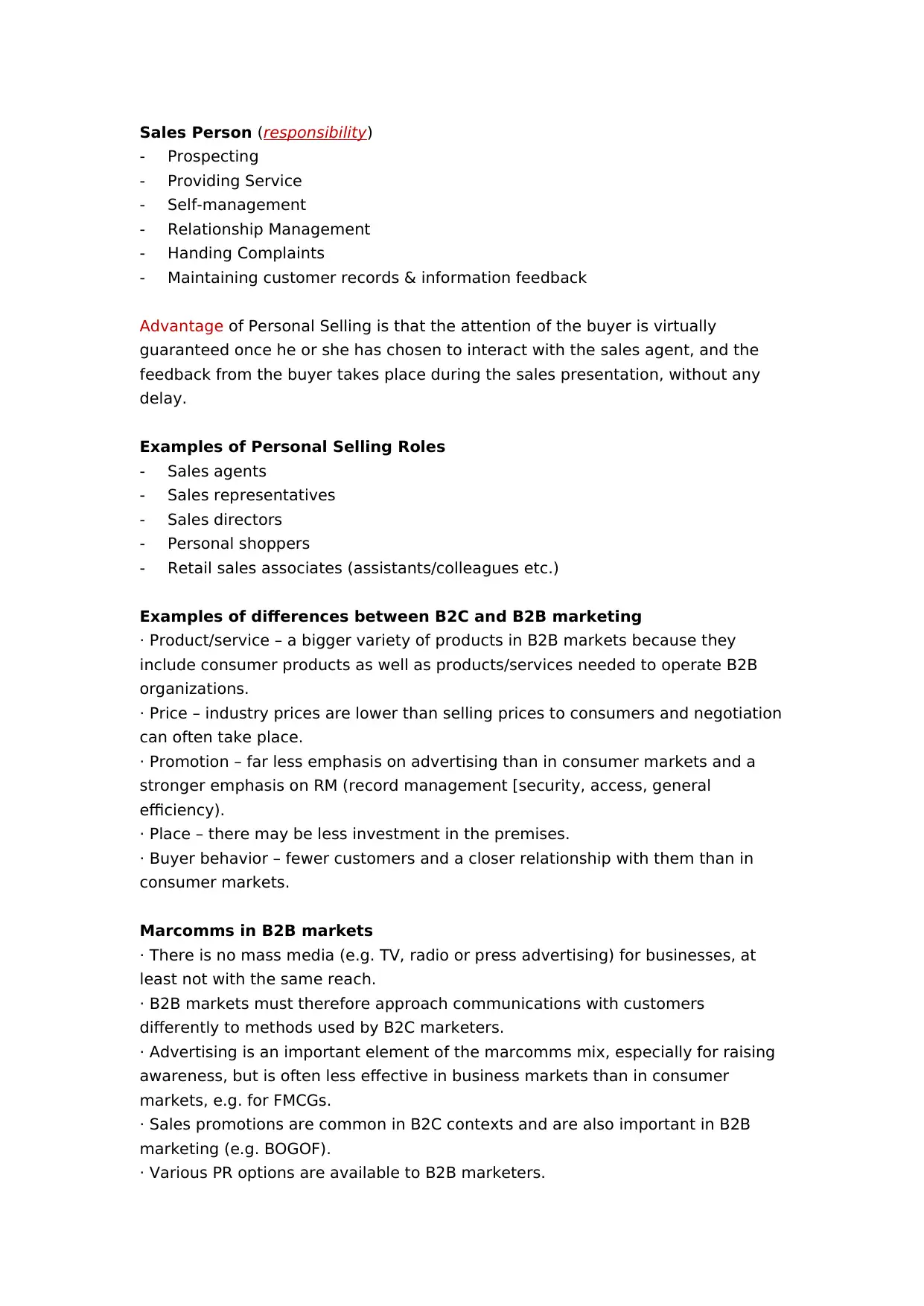
Sales Person (responsibility)
- Prospecting
- Providing Service
- Self-management
- Relationship Management
- Handing Complaints
- Maintaining customer records & information feedback
Advantage of Personal Selling is that the attention of the buyer is virtually
guaranteed once he or she has chosen to interact with the sales agent, and the
feedback from the buyer takes place during the sales presentation, without any
delay.
Examples of Personal Selling Roles
- Sales agents
- Sales representatives
- Sales directors
- Personal shoppers
- Retail sales associates (assistants/colleagues etc.)
Examples of differences between B2C and B2B marketing
· Product/service – a bigger variety of products in B2B markets because they
include consumer products as well as products/services needed to operate B2B
organizations.
· Price – industry prices are lower than selling prices to consumers and negotiation
can often take place.
· Promotion – far less emphasis on advertising than in consumer markets and a
stronger emphasis on RM (record management [security, access, general
efficiency).
· Place – there may be less investment in the premises.
· Buyer behavior – fewer customers and a closer relationship with them than in
consumer markets.
Marcomms in B2B markets
· There is no mass media (e.g. TV, radio or press advertising) for businesses, at
least not with the same reach.
· B2B markets must therefore approach communications with customers
differently to methods used by B2C marketers.
· Advertising is an important element of the marcomms mix, especially for raising
awareness, but is often less effective in business markets than in consumer
markets, e.g. for FMCGs.
· Sales promotions are common in B2C contexts and are also important in B2B
marketing (e.g. BOGOF).
· Various PR options are available to B2B marketers.
- Prospecting
- Providing Service
- Self-management
- Relationship Management
- Handing Complaints
- Maintaining customer records & information feedback
Advantage of Personal Selling is that the attention of the buyer is virtually
guaranteed once he or she has chosen to interact with the sales agent, and the
feedback from the buyer takes place during the sales presentation, without any
delay.
Examples of Personal Selling Roles
- Sales agents
- Sales representatives
- Sales directors
- Personal shoppers
- Retail sales associates (assistants/colleagues etc.)
Examples of differences between B2C and B2B marketing
· Product/service – a bigger variety of products in B2B markets because they
include consumer products as well as products/services needed to operate B2B
organizations.
· Price – industry prices are lower than selling prices to consumers and negotiation
can often take place.
· Promotion – far less emphasis on advertising than in consumer markets and a
stronger emphasis on RM (record management [security, access, general
efficiency).
· Place – there may be less investment in the premises.
· Buyer behavior – fewer customers and a closer relationship with them than in
consumer markets.
Marcomms in B2B markets
· There is no mass media (e.g. TV, radio or press advertising) for businesses, at
least not with the same reach.
· B2B markets must therefore approach communications with customers
differently to methods used by B2C marketers.
· Advertising is an important element of the marcomms mix, especially for raising
awareness, but is often less effective in business markets than in consumer
markets, e.g. for FMCGs.
· Sales promotions are common in B2C contexts and are also important in B2B
marketing (e.g. BOGOF).
· Various PR options are available to B2B marketers.
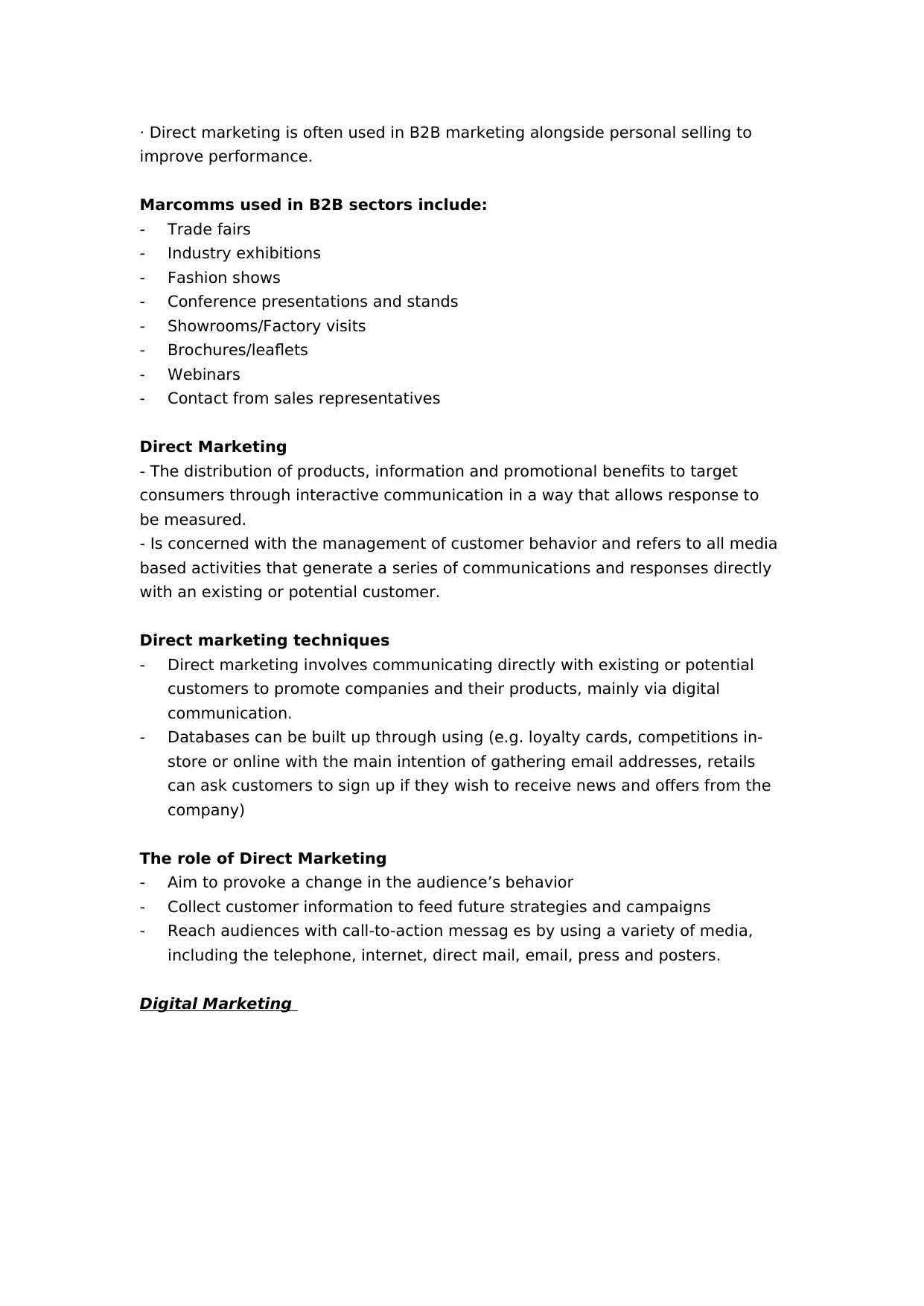
· Direct marketing is often used in B2B marketing alongside personal selling to
improve performance.
Marcomms used in B2B sectors include:
- Trade fairs
- Industry exhibitions
- Fashion shows
- Conference presentations and stands
- Showrooms/Factory visits
- Brochures/leaflets
- Webinars
- Contact from sales representatives
Direct Marketing
- The distribution of products, information and promotional benefits to target
consumers through interactive communication in a way that allows response to
be measured.
- Is concerned with the management of customer behavior and refers to all media
based activities that generate a series of communications and responses directly
with an existing or potential customer.
Direct marketing techniques
- Direct marketing involves communicating directly with existing or potential
customers to promote companies and their products, mainly via digital
communication.
- Databases can be built up through using (e.g. loyalty cards, competitions in-
store or online with the main intention of gathering email addresses, retails
can ask customers to sign up if they wish to receive news and offers from the
company)
The role of Direct Marketing
- Aim to provoke a change in the audience’s behavior
- Collect customer information to feed future strategies and campaigns
- Reach audiences with call-to-action messag es by using a variety of media,
including the telephone, internet, direct mail, email, press and posters.
Digital Marketing
improve performance.
Marcomms used in B2B sectors include:
- Trade fairs
- Industry exhibitions
- Fashion shows
- Conference presentations and stands
- Showrooms/Factory visits
- Brochures/leaflets
- Webinars
- Contact from sales representatives
Direct Marketing
- The distribution of products, information and promotional benefits to target
consumers through interactive communication in a way that allows response to
be measured.
- Is concerned with the management of customer behavior and refers to all media
based activities that generate a series of communications and responses directly
with an existing or potential customer.
Direct marketing techniques
- Direct marketing involves communicating directly with existing or potential
customers to promote companies and their products, mainly via digital
communication.
- Databases can be built up through using (e.g. loyalty cards, competitions in-
store or online with the main intention of gathering email addresses, retails
can ask customers to sign up if they wish to receive news and offers from the
company)
The role of Direct Marketing
- Aim to provoke a change in the audience’s behavior
- Collect customer information to feed future strategies and campaigns
- Reach audiences with call-to-action messag es by using a variety of media,
including the telephone, internet, direct mail, email, press and posters.
Digital Marketing
⊘ This is a preview!⊘
Do you want full access?
Subscribe today to unlock all pages.

Trusted by 1+ million students worldwide
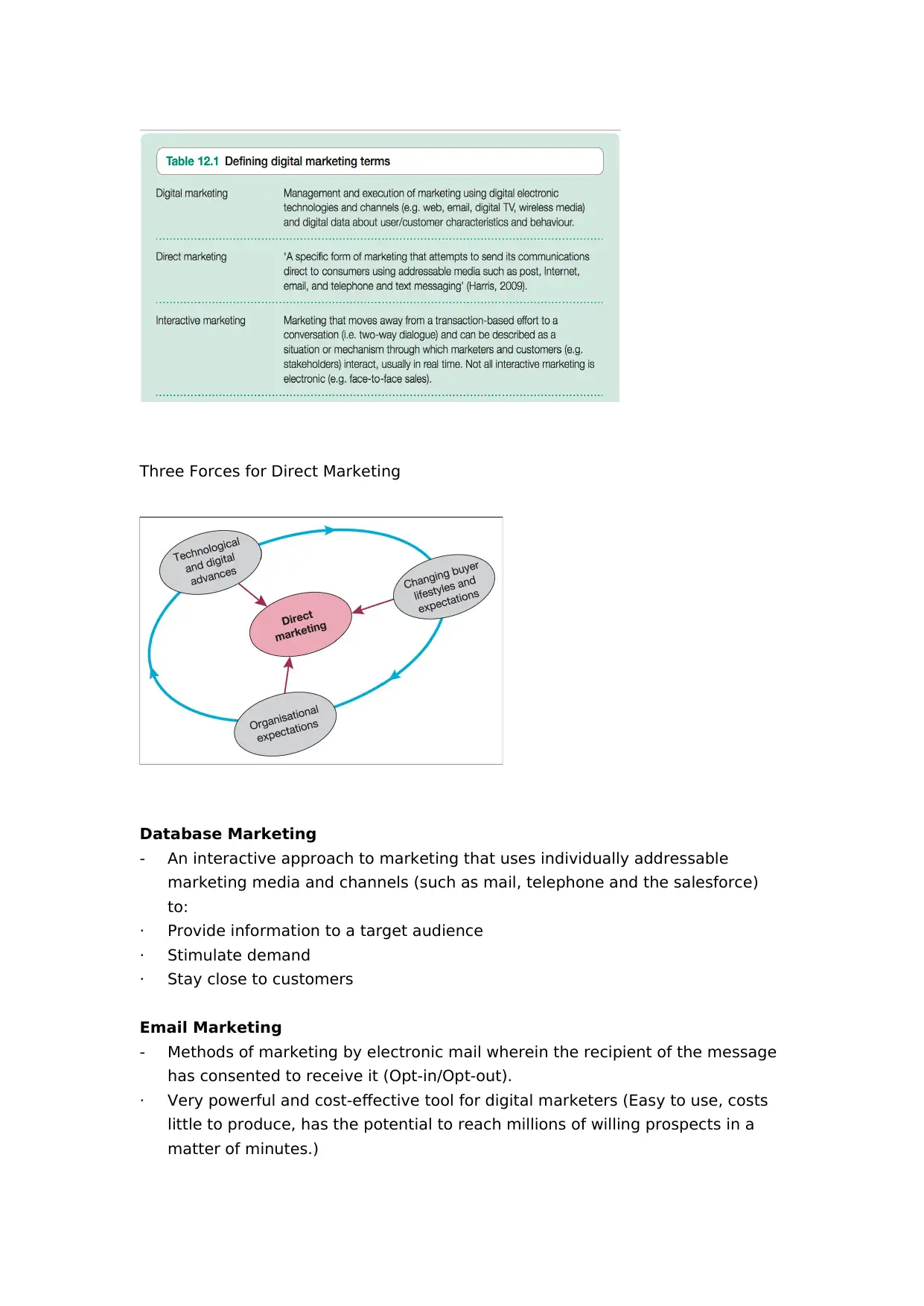
Three Forces for Direct Marketing
Database Marketing
- An interactive approach to marketing that uses individually addressable
marketing media and channels (such as mail, telephone and the salesforce)
to:
· Provide information to a target audience
· Stimulate demand
· Stay close to customers
Email Marketing
- Methods of marketing by electronic mail wherein the recipient of the message
has consented to receive it (Opt-in/Opt-out).
· Very powerful and cost-effective tool for digital marketers (Easy to use, costs
little to produce, has the potential to reach millions of willing prospects in a
matter of minutes.)
Database Marketing
- An interactive approach to marketing that uses individually addressable
marketing media and channels (such as mail, telephone and the salesforce)
to:
· Provide information to a target audience
· Stimulate demand
· Stay close to customers
Email Marketing
- Methods of marketing by electronic mail wherein the recipient of the message
has consented to receive it (Opt-in/Opt-out).
· Very powerful and cost-effective tool for digital marketers (Easy to use, costs
little to produce, has the potential to reach millions of willing prospects in a
matter of minutes.)
Paraphrase This Document
Need a fresh take? Get an instant paraphrase of this document with our AI Paraphraser
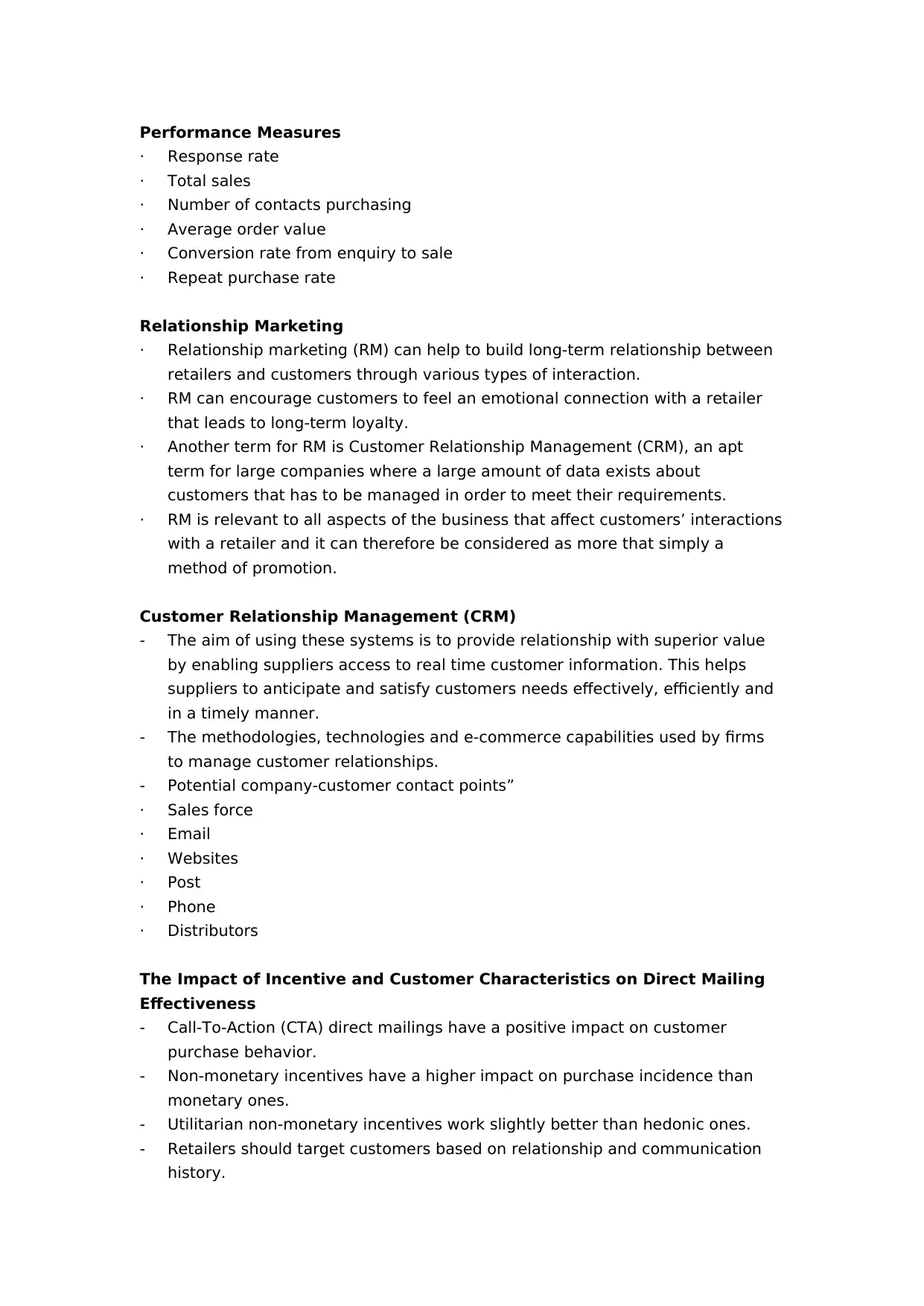
Performance Measures
· Response rate
· Total sales
· Number of contacts purchasing
· Average order value
· Conversion rate from enquiry to sale
· Repeat purchase rate
Relationship Marketing
· Relationship marketing (RM) can help to build long-term relationship between
retailers and customers through various types of interaction.
· RM can encourage customers to feel an emotional connection with a retailer
that leads to long-term loyalty.
· Another term for RM is Customer Relationship Management (CRM), an apt
term for large companies where a large amount of data exists about
customers that has to be managed in order to meet their requirements.
· RM is relevant to all aspects of the business that affect customers’ interactions
with a retailer and it can therefore be considered as more that simply a
method of promotion.
Customer Relationship Management (CRM)
- The aim of using these systems is to provide relationship with superior value
by enabling suppliers access to real time customer information. This helps
suppliers to anticipate and satisfy customers needs effectively, efficiently and
in a timely manner.
- The methodologies, technologies and e-commerce capabilities used by firms
to manage customer relationships.
- Potential company-customer contact points”
· Sales force
· Email
· Websites
· Post
· Phone
· Distributors
The Impact of Incentive and Customer Characteristics on Direct Mailing
Effectiveness
- Call-To-Action (CTA) direct mailings have a positive impact on customer
purchase behavior.
- Non-monetary incentives have a higher impact on purchase incidence than
monetary ones.
- Utilitarian non-monetary incentives work slightly better than hedonic ones.
- Retailers should target customers based on relationship and communication
history.
· Response rate
· Total sales
· Number of contacts purchasing
· Average order value
· Conversion rate from enquiry to sale
· Repeat purchase rate
Relationship Marketing
· Relationship marketing (RM) can help to build long-term relationship between
retailers and customers through various types of interaction.
· RM can encourage customers to feel an emotional connection with a retailer
that leads to long-term loyalty.
· Another term for RM is Customer Relationship Management (CRM), an apt
term for large companies where a large amount of data exists about
customers that has to be managed in order to meet their requirements.
· RM is relevant to all aspects of the business that affect customers’ interactions
with a retailer and it can therefore be considered as more that simply a
method of promotion.
Customer Relationship Management (CRM)
- The aim of using these systems is to provide relationship with superior value
by enabling suppliers access to real time customer information. This helps
suppliers to anticipate and satisfy customers needs effectively, efficiently and
in a timely manner.
- The methodologies, technologies and e-commerce capabilities used by firms
to manage customer relationships.
- Potential company-customer contact points”
· Sales force
· Websites
· Post
· Phone
· Distributors
The Impact of Incentive and Customer Characteristics on Direct Mailing
Effectiveness
- Call-To-Action (CTA) direct mailings have a positive impact on customer
purchase behavior.
- Non-monetary incentives have a higher impact on purchase incidence than
monetary ones.
- Utilitarian non-monetary incentives work slightly better than hedonic ones.
- Retailers should target customers based on relationship and communication
history.
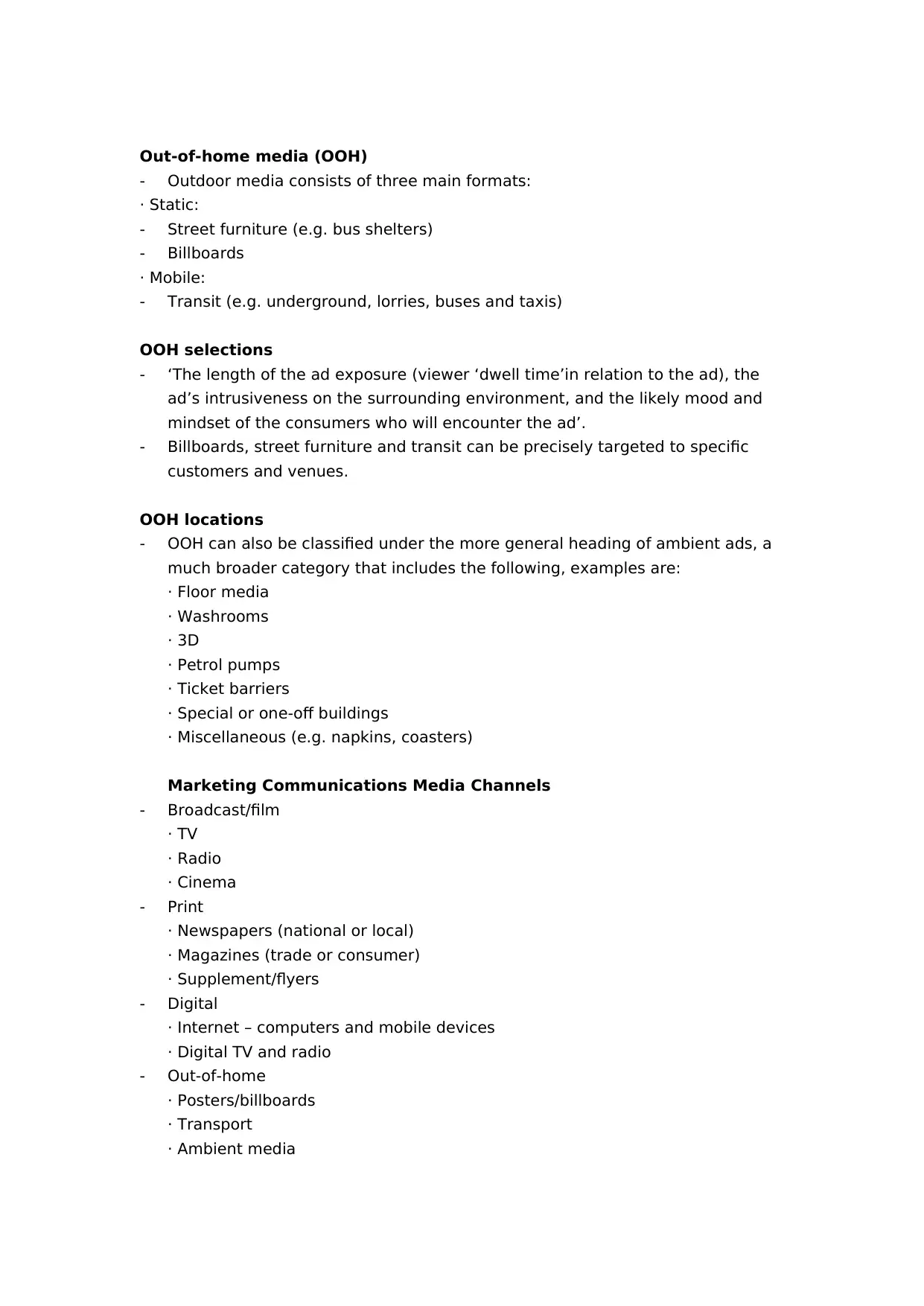
Out-of-home media (OOH)
- Outdoor media consists of three main formats:
· Static:
- Street furniture (e.g. bus shelters)
- Billboards
· Mobile:
- Transit (e.g. underground, lorries, buses and taxis)
OOH selections
- ‘The length of the ad exposure (viewer ‘dwell time’in relation to the ad), the
ad’s intrusiveness on the surrounding environment, and the likely mood and
mindset of the consumers who will encounter the ad’.
- Billboards, street furniture and transit can be precisely targeted to specific
customers and venues.
OOH locations
- OOH can also be classified under the more general heading of ambient ads, a
much broader category that includes the following, examples are:
· Floor media
· Washrooms
· 3D
· Petrol pumps
· Ticket barriers
· Special or one-off buildings
· Miscellaneous (e.g. napkins, coasters)
Marketing Communications Media Channels
- Broadcast/film
· TV
· Radio
· Cinema
- Print
· Newspapers (national or local)
· Magazines (trade or consumer)
· Supplement/flyers
- Digital
· Internet – computers and mobile devices
· Digital TV and radio
- Out-of-home
· Posters/billboards
· Transport
· Ambient media
- Outdoor media consists of three main formats:
· Static:
- Street furniture (e.g. bus shelters)
- Billboards
· Mobile:
- Transit (e.g. underground, lorries, buses and taxis)
OOH selections
- ‘The length of the ad exposure (viewer ‘dwell time’in relation to the ad), the
ad’s intrusiveness on the surrounding environment, and the likely mood and
mindset of the consumers who will encounter the ad’.
- Billboards, street furniture and transit can be precisely targeted to specific
customers and venues.
OOH locations
- OOH can also be classified under the more general heading of ambient ads, a
much broader category that includes the following, examples are:
· Floor media
· Washrooms
· 3D
· Petrol pumps
· Ticket barriers
· Special or one-off buildings
· Miscellaneous (e.g. napkins, coasters)
Marketing Communications Media Channels
- Broadcast/film
· TV
· Radio
· Cinema
· Newspapers (national or local)
· Magazines (trade or consumer)
· Supplement/flyers
- Digital
· Internet – computers and mobile devices
· Digital TV and radio
- Out-of-home
· Posters/billboards
· Transport
· Ambient media
⊘ This is a preview!⊘
Do you want full access?
Subscribe today to unlock all pages.

Trusted by 1+ million students worldwide
1 out of 25
Related Documents
Your All-in-One AI-Powered Toolkit for Academic Success.
+13062052269
info@desklib.com
Available 24*7 on WhatsApp / Email
![[object Object]](/_next/static/media/star-bottom.7253800d.svg)
Unlock your academic potential
Copyright © 2020–2025 A2Z Services. All Rights Reserved. Developed and managed by ZUCOL.





